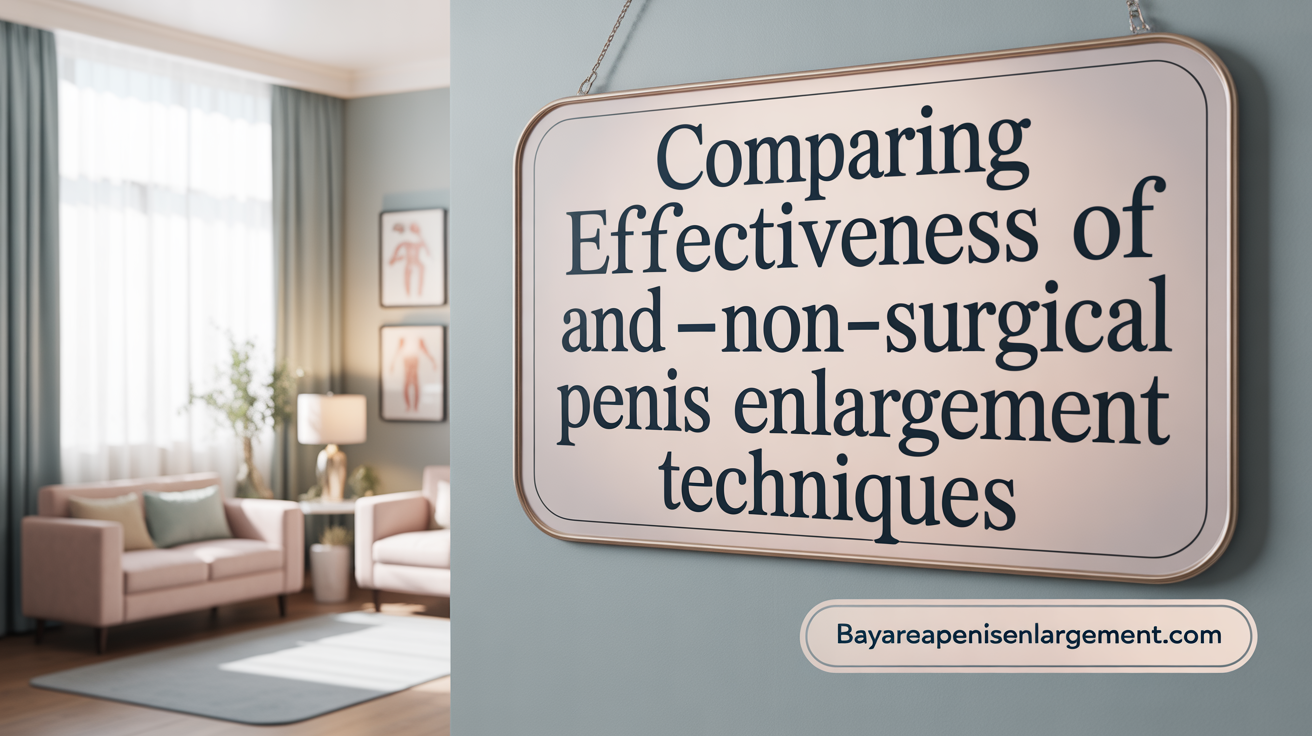Understanding the Scope of Penis Enlargement in 2025
As interest in penile enhancement continues to grow worldwide, 2025 presents new insights and comprehensive data on average sizes, enlargement techniques, safety profiles, and evolving trends. This article examines the latest scientific findings, surgical outcomes, demographic patterns, and technological advancements that shape the current landscape of penis enlargement.
Current Average Penis Sizes and Influencing Factors

What are the average penis sizes and girth based on current data?
Recent scientific studies provide a comprehensive view of average penis sizes. The average erect penis length is approximately 13.12 centimeters (5.17 inches). When flaccid, the average length measures about 9.16 centimeters (3.61 inches), and when stretched, it averages around 13.24 centimeters (5.21 inches). Girth, or circumference during an erection, averages roughly 11.66 centimeters (4.59 inches).
These figures suggest that most men fall within the standard size range. Variations are common and generally not indicative of any health problems. Interestingly, recent data shows an increase in average erect penis length over the years, with a 24% increase from 4.8 inches to 6 inches over the past three decades. This shift might be influenced by environmental factors or lifestyle changes.
Overall, human penises show a wide natural range. Most sizes are within normal limits, and extreme deviations are rare. Scientific consensus indicates that penis size has little to no impact on sexual satisfaction or function.
What factors influence penis size, and can it be increased naturally or through products?
Penis size is primarily shaped by genetics. Genes on the X and Y chromosomes influence development, along with hormonal levels like testosterone during fetal development and puberty. These genetic factors set the baseline for an individual's size.
Environmental influences also play a role. Exposure to endocrine-disrupting chemicals, nutrition, childhood health, and obesity can affect growth patterns. For instance, excess body fat around the pubic area can create the illusion of a smaller penis, but does not change its actual length.
Most variations in size remain within the standard range. There is limited scientific evidence supporting the idea that exercises, pills, or devices can significantly enlarge the penis. Claims of natural enlargement often lack peer-reviewed proof and can sometimes lead to health risks.
Congenital conditions like micropenis, which are rare, require medical intervention rather than reliance on enhancement products. Typical growth occurs during puberty, making this the main window for natural size increase.
In summary, while many seek to alter or increase their penis size, understanding the genetic and environmental factors involved can provide better insight. Most men are within the healthy size spectrum, and size does not define sexual satisfaction or ability.
Statistical Outcomes of Surgical Penis Enlargement Procedures
Penis enlargement surgeries aim to increase both length and girth, with typical results varying based on the procedure and individual factors. Most surgeries result in a flaccid length increase of approximately one to two inches. For erect length, patients may see an increase of about 0.5 to 1 inch, though these outcomes can differ widely.
In addition to length, girth enhancements are common. On average, patients experience around a 30% increase in penile girth following surgery. This improvement contributes to higher satisfaction among many men seeking enhancement.
Various surgical techniques are employed to achieve these results. One frequently used method involves dividing the suspensory ligament of the penis, which allows the organ to hang lower and appear longer. This procedure is relatively simple and yields noticeable length gains.
However, it’s important to understand that surgical outcomes depend heavily on individual circumstances and the specific method used. While many men are satisfied with their results, complications such as scarring, loss of sensation, or deviations can occur.
Overall, satisfaction rates tend to be high, especially when expectations are realistic and surgeons are experienced. Patients should consult qualified specialists to discuss potential benefits and risks before proceeding.
| Outcome Type | Typical Increase | Effect Duration | Additional Notes |
|---|---|---|---|
| Flaccid length | 1-2 inches | Permanent | Depends on surgical technique |
| Erect length | 0.5-1 inches | Permanent | Results vary among individuals |
| Girth | ~30% increase | Permanent | Subject to healing process |
For those seeking detailed statistics and updated results, a comprehensive review can be found with the search query: 'surgical penis enlargement outcomes and statistics 2025.'
Comparative Efficacy of Injection and Non-Surgical Methods

How effective are hyaluronic acid, poly L-lactic acid, polymethyl methacrylate, and silicone injections?
Injectable treatments have gained popularity due to their minimally invasive nature. Hyaluronic acid injections can increase penile girth by approximately 2.3 to 3.8 centimeters, with no serious complications reported, making them a safe option for many.
Poly L-lactic acid injections typically result in a girth increase of around 2.7 centimeters. The effects can last up to 18 months, providing a semi-permanent benefit.
Polymethyl methacrylate, a more durable filler, increases girth by about 2.4 centimeters but has been associated with palpable shaft abnormalities in roughly half of the patients.
Liquid silicone injections offer an average girth increase of approximately 2.6 centimeters and generally do not lead to serious short-term complications.
What about non-invasive traction therapies?
Penile traction therapy involves stretching the penis over extended periods. Although it produces small increases in length, these changes are often considered clinically insignificant and come with minimal side effects. This method is favored for its safety profile rather than dramatic results.
Are there promising developments in tissue engineering?
Recent advances in tissue engineering use biodegradable scaffolds to enhance penile size. These approaches demonstrate substantial girth increases averaging around 3.15 centimeters with few complications. Such innovations could pave the way for more effective and safer treatments in the future.
| Method | Average Girth Increase | Duration/Effectiveness | Notable Considerations |
|---|---|---|---|
| Hyaluronic Acid Injections | 2.3 - 3.8 cm | No serious complications reported | Safe, minimal downtime |
| Poly L-lactic Acid Injections | ~2.7 cm | Up to 18 months | Semi-permanent effect, need for repeat treatments |
| Polymethyl Methacrylate | ~2.4 cm | Long-lasting but with palpable abnormalities | Possible shaft irregularities |
| Liquid Silicone Injections | ~2.6 cm | No serious short-term complications | Safety profile favorable in the short term |
| Penile Traction Therapy | Small increments | Short-term, clinically insignificant | Minimal adverse effects, non-invasive |
| Tissue Engineering | ~3.15 cm | Promising, minimal complications | Still under research, future potential |
Overall, injection-based procedures offer moderate increases with good safety profiles, while emerging tissue engineering techniques hold promise for future enhancements.
Safety, Risks, and Patient Satisfaction in Penis Enlargement

What are the potential complications and side effects associated with various enlargement methods?
Different techniques for penis enlargement present varying levels of safety and possible adverse effects. Nonsurgical methods such as hyaluronic acid, poly-L-lactic acid, polymethyl methacrylate, and liquid silicone injections generally have mild to no serious complications reported. For instance, hyaluronic acid injections can increase girth by approximately 2.3 to 3.8 centimeters with no significant adverse events noted in studies.
However, some fillers like polymethyl methacrylate have been linked to a higher incidence (about 52%) of palpable shaft abnormalities. Liquid silicone injections also show a girth increase of around 2.6 centimeters but require careful consideration due to the risk of irregularities or long-term issues.
Surgical procedures, such as autologous fat injections, dermal fat grafts, or subcutaneous implants like Penuma, are generally safe but involve typical surgical risks such as infection, scarring, or graft failure. Penile prosthesis and tissue engineering techniques have demonstrated promising safety profiles with minimal complications.
How satisfied are patients with these procedures?
Patient satisfaction varies depending on the method used. Studies indicate that about 85% of women are satisfied with their partner’s penis size, whereas only 55% of men report satisfaction with their own size. Girth appears to be a primary concern for women, making girth enhancement procedures particularly desirable.
Procedures like subcutaneous penile implants and tissue engineering have high satisfaction rates, partly due to significant girth gains and low complication rates. Additionally, minimally invasive techniques offer immediate results, contributing positively to patient satisfaction.
What is known about long-term safety and effectiveness?
Long-term data is still emerging, but current studies show promising results. The effects of some injectable treatments, like poly-L-lactic acid, last up to 18 months, while tissue engineering techniques have demonstrated durable girth increases of about 3.15 centimeters.
Recent research suggests that environmental factors might be contributing to an increase in average erect penis length over the past decades, but the long-term safety of many newer procedures remains under continuous evaluation. Overall, selecting a procedure with proven safety and sustained results is crucial for optimal patient outcomes.
| Method | Average Girth Increase | Duration of Effect | Notable Risks / Complications | Satisfaction Rate |
|---|---|---|---|---|
| Hyaluronic acid | 2.3 - 3.8 cm | Not specified | Minimal, no serious issues reported | High |
| Poly-L-lactic acid | ~2.7 cm | Up to 18 months | Generally safe, monitor for swelling and bruising | Moderate to high |
| Methyl methacrylate | ~2.4 cm | Not specified | 52% experience palpable abnormalities | Moderate |
| Liquid silicone | ~2.6 cm | Short-term | Risk of irregularities, long-term issues | Moderate |
| Surgical fat grafts | 2 - 3 cm | Long-term | Infection, scarring | High |
| Penuma implants | Significant girth gains | Long-term | Low adverse event rates | Very high |
| Tissue engineering | ~3.15 cm | Not specified | Minimal, ongoing research | Promising |
This overview highlights that while many procedures are effective, their safety profiles vary. Continuous research and consultation with qualified specialists are essential for optimal, safe outcomes.
Global Trends and Demographics in Penis Enlargement Procedures
Penis enlargement surgeries have seen a notable rise globally, with an estimated 15,414 procedures performed in 2013 alone. Germany leads in regional numbers, with about 2,786 surgeries that year, making it the country with the highest volume in Europe. This trend indicates increasing interest, possibly driven by the desire for enhanced self-confidence or societal pressures.
The procedures vary in popularity across different regions, influenced by cultural, economic, and healthcare factors. In Germany, specialized clinics like the German Centre for Urology and Phalloplasty Surgery have performed over 6,000 procedures, typically resulting in girth increases of 2-3 cm and length gains of 3-6 cm. The cost of these surgeries at such centers averages around €9,600, which includes materials and related costs.
In terms of accessibility, these procedures are more common in countries with advanced healthcare systems and higher disposable incomes. While most surgeries are performed discreetly, the high demand in certain nations signifies a broader acceptance and normalization of such treatments.
Here is a summary of regional statistics and cost estimates:
| Region/Country | Estimated Surgeries (2013) | Typical Girth Increase | Typical Length Increase | Cost Range (EUR) |
|---|---|---|---|---|
| Germany | 2,786 | 2-3 cm | 3-6 cm | 8,000-10,000 |
| Worldwide | 15,414 | Varies | 2-3 cm (average) | 9,600 (center average) |
The ongoing global trend points toward increasing acceptance and availability of both surgical and nonsurgical penile enlargement options, with cost and regional factors playing significant roles in access.
Technological Advancements and Future Outlook for Penis Enlargement

Emerging Technologies in Penile Enlargement
Recent innovations in medical technology have opened new frontiers for penile enlargement procedures. Tissue engineering using biodegradable scaffolds has shown promising results, with studies reporting an average girth increase of around 3.15 cm and minimal complications. Additionally, subcutaneous penile implants, such as the Penuma device, have gained popularity due to high patient satisfaction and low adverse event rates. These implants can significantly increase girth and are often preferred for their minimally invasive nature.
Surgical options like autologous fat injections and dermal fat grafts typically provide girth enhancements of 2 to 3 cm with low complication risks. Conversely, penile prosthesis implantation mainly aims to increase girth by about 1 cm while maintaining or slightly extending length.
Projected Trends in Size Averages and Popularity of Procedures
Over the past decades, data suggests an increase in average erect penis lengths, rising from approximately 4.8 inches in 1942 to about 6 inches in 2023—a 24% increase. This shift could influence demand for enlargement procedures, especially as awareness and acceptance grow.
Procedures like hyaluronic acid and poly L-lactic acid injections provide quick, office-based girth increases, typically around 2 to 3.8 cm, with no serious complications reported. These nonsurgical methods are increasingly popular due to their safety and immediate results.
Environmental and Lifestyle Influences on Future Data
Environmental factors such as pollution, sedentary habits, and lifestyle choices are believed to contribute to changes in penile size over time. A comprehensive study compiled data from 75 research articles spanning nearly 80 years, indicating that the average erect penis length has increased from 4.8 inches to 6 inches, possibly due to these external influences.
Some experts suggest that lifestyle modifications, reduced exposure to pollutants, and advances in medical technology will continue to influence future trends. The understanding that penile girth is often the attribute men and women prioritize could further drive the development and acceptance of various enlargement procedures.
| Topic | Current Data / Trends | Future Outlook |
|---|---|---|
| Average penis length | 4.8 to 6 inches (historical increase) | Likely to continue increasing due to environmental factors |
| Popular procedures | Hyaluronic acid, fat grafts, implants | Growing acceptance of minimally invasive options |
| Main factors influencing size | Environment, lifestyle, technology | Increased influence of environmental health and regulation |
With ongoing technological advancements and increased societal awareness, the landscape of penile enlargement is poised for significant evolution by 2025. These developments aim to make procedures safer, more effective, and aligned with patient satisfaction and natural growth trends.
Summarizing Penis Enlargement Insights for 2025
The data and research from 2025 highlight a nuanced picture: average penis size appears to have increased modestly over recent decades, and a variety of surgical and non-surgical methods offer measurable size enhancements with varying safety profiles. Geographic trends point to growing acceptance and availability of enlargement procedures, particularly in specific regions. Technological innovations such as tissue engineering and advanced implants show promise for safer and more effective outcomes. Understanding the statistics and scientific findings helps inform realistic expectations and underscores the importance of evidence-based approaches in penile enhancement.
References
- Penile enhancement: A comprehensive and current perspective - PMC
- Average Penis Size and What's Considered Big - Verywell Health
- Germany: the world's capital of penis enlargement - The Guardian
- What is the Average Penis Size: Facts, Figures, and Factors
- Is an increase in penile length cause for concern? - Stanford Medicine
- Average Penis Size: What Determines It - WebMD
- What is the average penis size? - Medical News Today
- Average Penis and Erection Size: What's "Normal?" - Healthline

